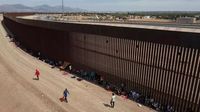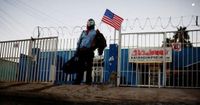The United States authorities are taking steps to intensify their efforts at securing the southern border by extending the length of the protective wall along the Mexico border by another 11 kilometers. This significant announcement was made on March 17, 2025, by U.S. Homeland Security Minister Christie Noem, who spoke from Arizona, where the need for increased border security was visually evident. "I am in Arizona, and from here you can see where the border wall ends. Starting today, we are starting to build another 7 miles (more than 11 km) of wall. We will continue to do this to make America safe again," she declared.
Noem's comments underline the administration's renewed dedication to filling gaps along the border, which have drawn attention as illegal immigration spikes. The extended construction closely aligns with previous statements made by President Donald Trump, who maintained discussions of national security and immigration control at the forefront of his presidency.
Trump has long advocated for the completion of the wall, signing emergency decrees soon after taking office aimed at mobilizing federal resources for this purpose. His administration has faced scrutiny and spirited debate over its immigration policies, but the project has remained one of the central elements of his agenda. Noem's recent announcement revives and reinforces this focus following alarming immigration statistics.
Adding to the urgency of the construction effort, U.S. Vice President Jay De Vance remarked earlier this month, "President Trump expects to complete the construction of the wall on the border with Mexico by the end of his second term in office in 2029." This ambitious target demonstrates the administration's unwavering commitment to fortifying defenses against what it perceives as incursion threats.
The comments from both leaders reflect broader concerns about national security and the management of illegal migration across the southern border, issues which have ignited considerable political and social discourse across the nation. On one hand, supporters of the wall argue it is necessary to protect U.S. sovereignty, deter illegal crossings, and uphold laws governing immigration. On the other hand, critics claim such measures demonize migrants, often fleeing violence and economic turmoil, framing the wall as emblematic of divisive politics and exclusionary practices.
Vocal voices from various communities continue to decry the wall as ineffective, arguing it does little to solve the underlying issues driving migration, such as violence, poverty, and political instability. Yet the Trump administration’s resolute stance is clear, aiming to construct not only physical barriers but also to establish policies perceived as safeguarding American lives and livelihoods.
The endeavor to expand the wall speaks to the longstanding challenges the U.S. faces as it grapples with its immigration policies. Heightened enforcement measures have presented mounting pressures at the border, creating complex scenarios for local and federal agencies tasked with managing these situations.
While some may celebrate the physical manifestation of enhanced border security, others express concerns over the human costs associated with such policies, particularly considering families separated by migration enforcement. The wall is not merely concrete and steel; it symbolizes the tensions within U.S. society as it navigates the tightrope of national security and humanitarian compassion.
With plans to break ground on this 11-kilometer extension immediately, officials are poised to kickstart this venture amid mounting pressures and expectations. The coming months will likely see increased discussions and reactions from local communities, advocacy organizations, and policymakers alike, as the border wall continues to shape the narrative of U.S. immigration policy.
The expansion's timing could fundamentally influence key political winds as mid-term elections approach, as candidates will be expected to clarify their stances on immigration—one of the most pivotal issues facing American voters today. Stakeholders from every walk of life are already voicing their positions on the matter, creating what is sure to be compelling discourse surrounding the effectiveness and ethics of the proposed safeguard measures.
Discussions surrounding the border wall's intended purpose, effectiveness, and societal impact continue to fuel public and political interest. If completed, this expansion could present significant operational changes to current immigration protocols at the southern border, concurrently engaging officials and residents alike.
While the goal is clear, how effectively such measures will address the challenges at the border remains to be seen. Will enhanced security bring about the safety desired, or will the focus instead shift to finding comprehensive solutions to immigration reform as the nation moves forward? The answers may depend on not only this construction project, but also on the collective will of the country's leaders and citizens.





